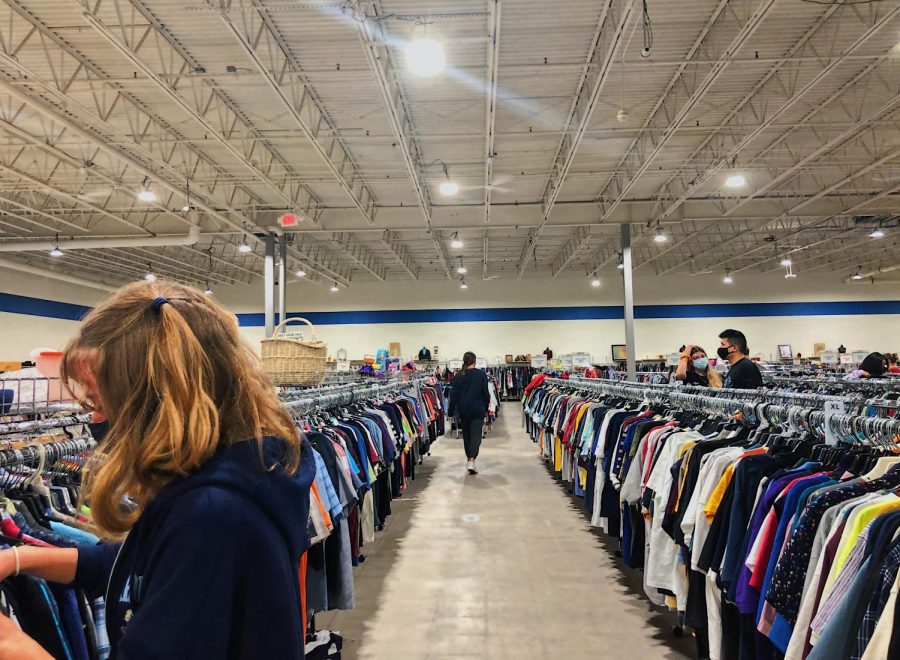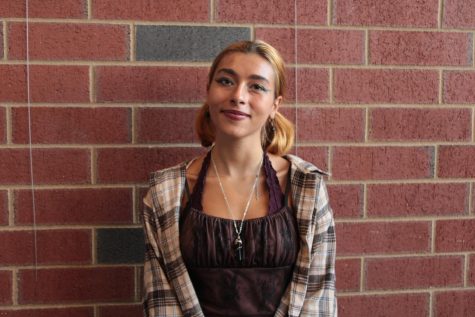The Surge of Second-Hand Shopping
Inside the newly moved Goodwill location on Benner Pike in State College, PA, taken on Nov. 18, 2020. Although masks are required in the store, those who don’t feel safe shopping in person now have access to Goodwill online as of last year, along with additional second-hand platforms such as ThredUp, Depop, Poshmark, and more.
January 10, 2021
In the past decade, second-hand shopping has made its way into the mainstream, especially for high schoolers. From upscale vintage boutiques to vast donation centers, second-hand shopping has become both a means of survival and a weekend hobby. For many, the huge popularity that thrifting has gained in the past few years came as a surprise, as the stigma of something that was once labeled “trashy” shifted to being “trendy.”
While the gentrification of thrifting has led to it being viewed as an “acceptable” practice now, it has also added some strains on the groups of people that have always relied on it. Social media played a vital role in this cultural makeover, but the long-term effects of it are yet to be seen.
Our culture and generation specifically has been reshaped by the internet in practically every facet of life. YouTube channels like Emma Chamberlain or BestDressed are clear examples of how the practice of remaking, reselling, and second-hand shopping was introduced to a whole new audience. According to The Robin Report in 2019, ThredUp (a popular online thrifting platform) predicts that the resale market, now around 30 billion, will reach 51 billion dollars by 2023.
Junior Ainsley Paulsen used to work at Plato’s Closet. Paulsen herself enjoys thrifting once in a while as it’s such an affordable option, and noticed first-hand the different demographics within the stores.
“There were definitely a lot of teens that used to come in with their friends, especially on the weekends. I feel like thrifting is an appealing way to shop because it’s like, guilt-free. You don’t have to spend a lot of money like you would at Urban Outfitters,” Paulsen said.
There is no doubt about the massive benefits that shopping second-hand brings to the average consumer. Environmental sustainability, low prices, and individuality all come hand in hand with thrift shopping. Minimizing your carbon footprint through spending habits can have seriously impactful results, especially due to the fact that in this century alone, Americans specifically have become enraptured in a hyper-consumerist culture. When fast-fashion allows clothes to come at cheap prices and new trends pressure a new wardrobe every other month, over-consuming on unnecessary items is inevitable.
According to the University of California Berkeley in 2019, in the past decade, consumers in the U.S. are buying four times the amount of clothing they used to but spending 17% less money on them. Fast fashion, though bad for the environment, is often the only option for people in lower-income brackets that wish to keep up with ever-changing trends. Environmental sustainability in fashion has more often than not been exclusive to those with the luxury to afford it. Many people can’t afford to spend $100 on a pair of ethically made jeans, making thrift shopping one of the only routes available that is both affordable and sustainable.
However, low prices at thrift stores may be leading to merely an increase in the consumerist culture of shopping. For people who don’t need to shop second-hand, five-dollar jeans are seen as more “disposable”, and therefore can be bought ten times a week and replaced the next. Furthermore, in recent times, the practice of going into thrift stores and then reselling cheap items online for more than their worth has become commonplace on reselling apps like Depop. When teens go into these thrift stores without the intent of actually wearing the clothes they purchase, this can lead to an increase in prices in places like Goodwill. This leaves those who depend on thrift shopping for necessities being forced to spend more and more.
With all this in mind, the blame for the increase in prices due to the increase of purchases and shoppers in the thrifting scene can’t necessarily be placed on shoppers. Consuming affordable fashion while still being sustainable leaves everyone between a rock and a hard place. One way to avoid problems like price increase or clothing scarcity is to ensure that clothing is recirculated into the thrift market by giving back to the donation centers you shop at.
As cold weather and the holiday season approaches, thrift stores become more and more essential to the State College community. This year, consider donating warm clothes to your local donation center or religious center organizing items for the same purpose. Second-hand shopping, when done consciously, provides a safety net within communities that many rely on.


